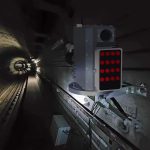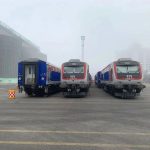In 2021, China’s urban rail and subway will bid for a total of 43 projects, involving nearly 5,000 vehicles, and the winning bid amount is nearly 35 billion yuan. Among them, Beijing Metro Vehicle Equipment Co., Ltd. (hereinafter referred to as “Jingche Equipment”) won the bid for 2 projects, involving nearly 150 vehicles. The winning bid amounted to about 900 million yuan.
Seven factories delivered nearly 10,000 vehicles
Beijing Investment Corporation is the only investor in the field of rail transit in Beijing, and Beijing Investment Corporation is the controlling shareholder of Beijing Car Equipment. Jingche Equipment Co., Ltd. is one of the seven domestic enterprises with the qualification to produce urban rail vehicles, and the only one of the seven companies that is not affiliated to CRRC Corporation Limited (601766.SH, hereinafter referred to as “CRRC”).
In 2021, among CRRC’s six urban rail metro factories, CRRC Nanjing Puzhen Vehicle Co., Ltd. (hereinafter referred to as “Nanjing Puzhen”) will win the highest bid for metro vehicles, accounting for about one-third of the total market share; The amount is followed by CRRC Changchun Railway Vehicle Co., Ltd. (hereinafter referred to as “Changchun Railway Vehicle Co., Ltd.”) and Qingdao Sifang Locomotive Co., Ltd. (hereinafter referred to as “Qingdao Sifang”), which together account for about 40% of the total market share.
The 4th and 5th bid winners are CRRC Zhuzhou Electric Locomotive Co., Ltd. (hereinafter referred to as “CRRC Zhuzhou”) and CRRC Dalian Locomotive Co., Ltd. (hereinafter referred to as “CRRC Dalian”). Including Jingche Equipment, CRRC Tangshan Locomotive and Rolling Stock Co., Ltd. (hereinafter referred to as “CRRC Tangshan”) has won the least bid among the seven major OEMs, and there will be no bid-winning projects in 2021.
Looking at the bidding cities, the data provided by the China Urban Rail Transit Association (hereinafter referred to as the “Urban Rail Transit Association”) shows that in 2021, Suzhou urban rail vehicles will be the first in China with more than 700 tenders, accounting for nearly 100% of the number of tenders in China. 15%; followed by Chongqing and Nanjing, both accounting for about 10%. The number of bidders from 4 to 9 are Zhengzhou, Changsha, Changchun, Dalian, Wuhan and Guiyang; the 10th is Shenyang, and about 250 subway vehicles will be tendered in 2021, accounting for about 5% of China’s.
According to data from CRRC and Jingche Equipment, in 2021, China’s seven major urban rail subway OEMs will deliver more than 9,100 vehicles, of which CRRC will deliver nearly 9,000 vehicles, a year-on-year decrease of nearly 10%. In terms of sales revenue, the highest among these seven OEMs is Changke Shares, with sales revenue of nearly 15 billion yuan, followed by Nanjing Puzhen, CRRC Zhuji, Qingdao Sifang, CRRC Tangshan, CRRC Dalian, and Jingche. The minimum equipment sales revenue is about 1 billion yuan, and the total sales revenue of China’s seven major OEMs is about 51.5 billion yuan.
Integrate resources and consolidate the market
In terms of profit margins of the subway segment, Nanjing Puzhen ranked the highest with a profit margin of more than 20%, followed by CRRC Zhuji, Qingdao Sifang, CRRC Tangshan and Changke Co., Ltd. in accordance with the gradually decreasing profit margin; CRRC Dalian was less than The 13% profit margin ranks last.
In the past two years, among the various types of urban rail subway products, subway products accounted for the largest proportion, accounting for more than 95%; urban fast rail, trams, maglev trains, and electronically guided rubber wheel systems accounted for 3%, 0.7%, and 0.15% respectively. % and around 0.05%. The proportion of product standards is basically in line with the proportion of mileage opened by various systems of urban rail transit in recent years. According to data from the Urban Rail Association, in 2021, a total of 1,222.92 kilometers of new urban rail transit lines will be added in mainland China, of which 971.93 kilometers of subways have been opened, accounting for 79.48%. ; 133.15 kilometers of urban express rail, 46.31 kilometers of straddle-type monorail, 38.73 kilometers of trams, 15.4 kilometers of rail-type rubber wheel system, 14.0 kilometers of electronically guided rubber wheel system, 2.2 kilometers of light rail, and 1.2 kilometers of maglev traffic.
CRRC’s target revenue for the urban rail segment in 2021 is 60 billion yuan, and the actual revenue is more than 90% of the target revenue. The sales revenue target in 2022 is about 57 billion yuan, and the gross profit margin of the segment should be increased by 1%.
In 2022, the bidding for the new subway vehicle market in mainland China will resume, and it is estimated that 7,000 to 8,000 vehicles will be tendered throughout the year.
Overcapacity still exists
CRRC’s “2021 Annual Report” shows that in 2021, CRRC’s operating income will be 225.732 billion yuan, a year-on-year decrease of 0.85%, and its net profit will be 10.303 billion yuan, a year-on-year decrease of 9.08%. This is after the two indicators dropped in 2020. Double down again. Among the total revenue, urban rail and subway revenue was 54.556 billion yuan, a year-on-year decrease of 6.01%. According to CRRC, the decline was mainly due to the decline in the revenue of urban rail vehicles.
According to the “2021 China Urban Subway Passenger Traffic Report” released by the Urban Rail Association, as of December 31, 2021, the mileage of subways in mainland China was 7,253.73 kilometers, a year-on-year increase of 15.47%. The “2021 Overview of Urban Rail Transit Lines in Mainland China” released by the Urban Rail Association in the same period also shows that in 2021, a total of 50 cities in Mainland China will open urban rail transit (subway, urban express rail, straddle monorail, tram, guide rail) Type rubber wheel system, electronic guide rubber wheel system, light rail, maglev transportation) operating mileage of 9192.62 kilometers. Among them, the subway accounts for 78.9% (for details, please refer to the report of China Business Network on February 17, 2022, “China’s subway passenger volume recovers and the urban rail operation mileage is close to 10,000 kilometers”).
China’s urban rail industry has long implemented enterprise-designated qualifications. There are 7 domestic enterprises with urban rail vehicle production qualifications that can produce subway, light rail and other rail transit products, including 6 subsidiaries of CRRC and Beijing Railway, a wholly-owned subsidiary of Beijing Investment Corporation. equipment. Among the six CRRC subsidiaries, Nanjing Puzhen, Qingdao Sifang and CRRC Zhuji belong to the former CSR; Changke Co., Ltd., CRRC Tangshan and CRRC Dalian belong to the former CSR.
According to the 2021 semi-annual report of CRRC, the annual production capacity of CRRC urban rail vehicles in China is 11,800 vehicles. The annual bidding volume is only about 40% of the annual production capacity, and the problem of overcapacity of urban rail vehicles in China is serious.
In this regard, CRRC said that CRRC, including urban rail vehicles, has the contradiction of overcapacity in some sectors of rail transit and is facing industrial structural adjustment. CRRC has set up a special organization to study reform plans, and optimize resource allocation through business restructuring and capacity reduction in accordance with different strategies and principles for different sectors. CRRC will strictly control the total assembly capacity of the above-mentioned vehicles, vigorously promote the “integration of repair and manufacture” of EMUs, urban rail vehicles and locomotives, promote the sharing of repair and new manufacturing resources, and improve the utilization rate of new manufacturing capacity of EMUs, urban rail vehicles and locomotives.


